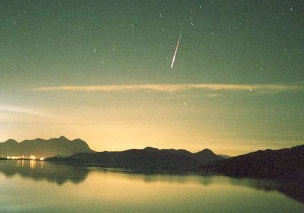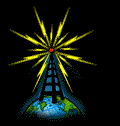

![]()

![]()

Meteor Scatter is another type of propagation I like to use when I can. This allows for contacts from about 500 to 1500 miles.
50 MHz through 432 MHz can be used for this type of propagation. When meteors travel through the ionosphere, they leave behind ionized trails which can be used to reflect radio signals. This ionization takes place in the E-Layer of the ionosphere. The ionization can last anywhere from a fraction of a second to several minutes.
The 6 meter band, and 2 meter band are excellent bands for meteor scatter work. Very early in the morning around dawn is probably one of the best times to try for meteor scatter contacts. Contacts on 50 MHz and 144 Mhz can be made almost any morning.
The higher the frequency, the more difficult it is to complete a meteor scatter contact. The reflected signal strength and the amount of time a signal can be reflected decrease as the operating frequency goes up. A meteor trail that might last 30 seconds on 50 MHz may only last 3 seconds on 144 MHz, or less than a second on 432 MHz.
The very best times to try for meteor scatter contacts is during one of the several major meteor showers that we have each year. This takes place when the earth passes through a stream of particles left over from one of several comets that orbit around the sun. Computer software is available to predict the times that these meteor showers occur. Check out OH5IY's website for an excellent meteor shower prediction program called MS-Soft.
Special operating procedures are used when working meteor scatter. Usually pre-arranged scheds are made to determine time, frequency and sequencing. Usually each station transmits on alternate 15 second periods until enough information is gathered to be considered a valid contact.
Random contacts are also popular on 50 and 144 MHz, but are more difficult. Scheds are made on 3.818 MHz on the 75 meter band. This is the CSVHF net frequency. Also the moon-bounce frequency of 14.345 on 20 meters is used during the major showers to arrange scheds.
Probably the easiest way now to make schedules is via the internet. You can go to the MS ROCKS LIVE website to make on-line scheds. There are also several meteor-scatter mailing lists you can subscribe to on the internet.
Since the majority of the meteors falling only allow a signal to be reflected for a very short time, maybe a fraction of a second, a method called HSMS or High Speed Meteor Scatter is often used. This method has been popular in Europe for many years, but is just now gaining popularity in North America.
This involves recording your data in Morse code and transmitting this data at a very high rate of speed, say 4000 lpm (letters per minute), or 800 wpm (words per minute). The receiving station on the other end, during his receive period, records what he is hearing on his receiver. If he hears a small burst he then replays this recorded burst of data back at a much slower speed, say 40 times slower, and is able to hear the required data he is looking for.
At these speeds a
small meteor burst or ![]() "PING" can contain a lot of
data. This allows an amateur to take advantage of the many small
meteor bursts and complete more contacts. These days usually a
computer and suitable software are used for the recording and
playback of the data. Software can be found in some of the links
below. My favorite HSMS computer program is called MS DSP.
"PING" can contain a lot of
data. This allows an amateur to take advantage of the many small
meteor bursts and complete more contacts. These days usually a
computer and suitable software are used for the recording and
playback of the data. Software can be found in some of the links
below. My favorite HSMS computer program is called MS DSP.

(Image by Yan On Sheung, 2200 UTC, 16 Nov 1998.)
High power and a high gain beam antenna are desired for meteor scatter, but not always necessary. I use 150 watts to a 5 element yagi on 6 meters and 200 watts to a 16 element cross-yagi on 2 meters. This has allowed me to complete many QSO's on both of these bands.
*Note - If you have the capability of stacking several high gain antennas and feeding them with a full legal limit linear amplifier your results will be much better. With this type of propagation the higher the ERP (Effective Radiated Power) the better.
During the Leonids 98 shower I completed many 144 MHz "Randoms". I started at 17:45 UTC, on November 16.The first dozen or so were all worked without an amplifier. I was running 20 watts p.e.p. output to my 16 element cross-yagi. Many contacts would have been possible using QRP power levels during this shower. For the remainder of the shower I put a Mirage B1016 solid state "brick amplifier" in line and ran with 100 watts p.e.p. output. Several more "Randoms" were completed between 07:30 UTC, November 17 and 10:00 UTC, November 17. This was by far the best meteor shower I have ever participated in since becoming licenced in 1983.
*Note - Thanks to Dale, VE6NON, for lending me the Mirage amplifier for Leonids 98.
I have always had good luck with the Leonids shower. The speed at which the meteors enter the earths' atmosphere is extremely fast with this particular shower which makes for more intense ionization. This allows the use of lower power. Give the Leonids a try!

Some Meteor Scatter Links
